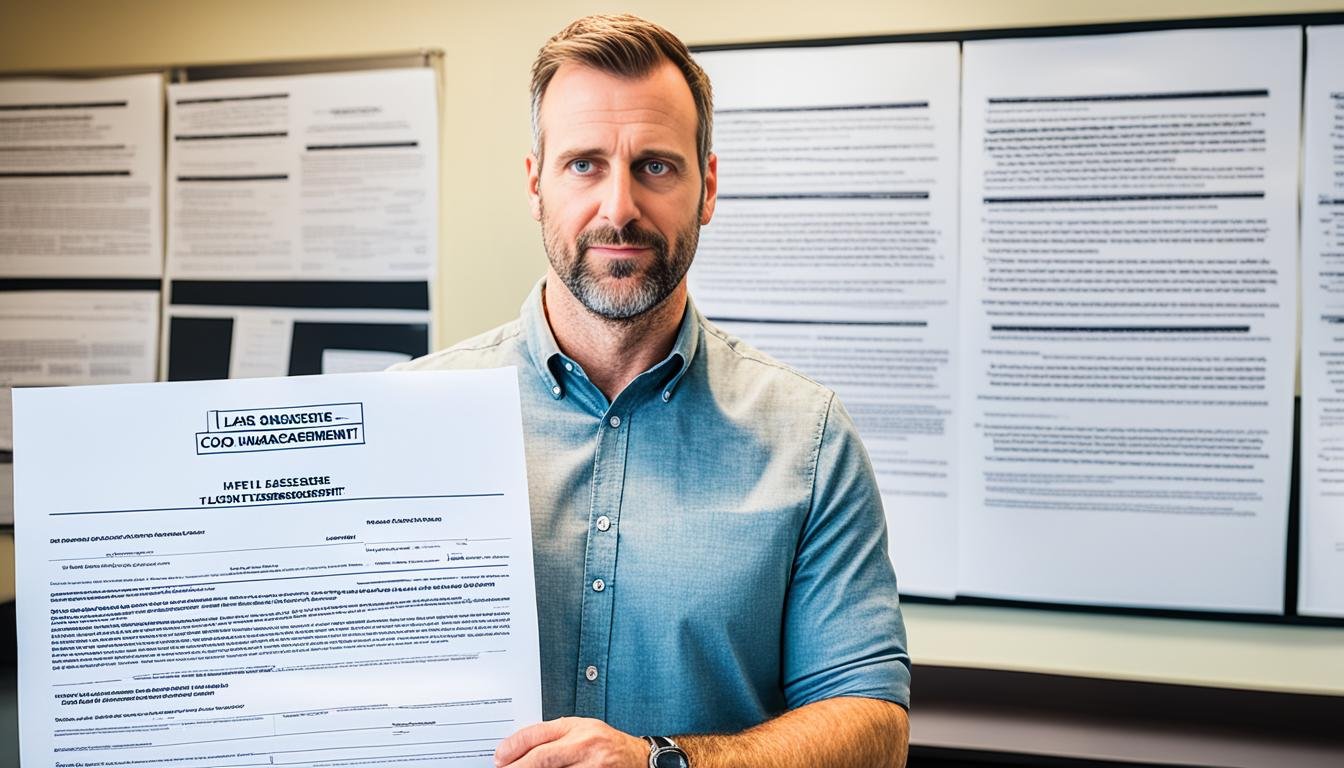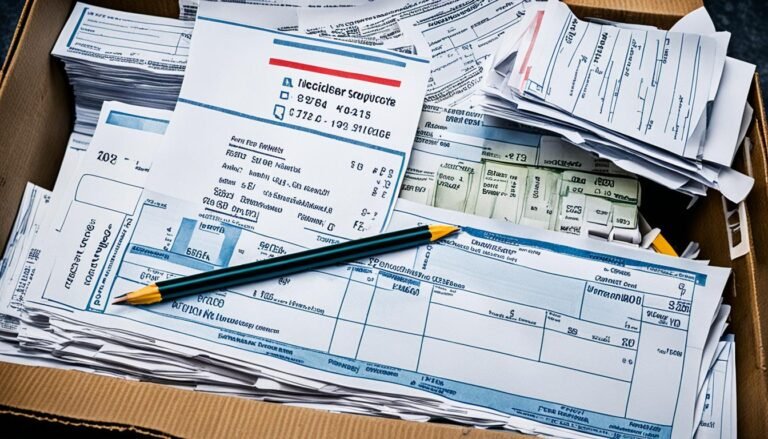Lease Agreements Decoded for SMEs
Lease agreements are very important for small businesses renting commercial spaces. They provide a set structure that helps both the landlord and the tenant feel safe. It makes the rental experience better for everyone. As a landlord or a tenant, it’s vital to know the main parts of a lease. This knowledge stops problems and makes sure your rights are safe. Let’s look at lease agreements closely and see why they matter to small businesses.
Key Takeaways:
- Lease agreements are legally binding contracts that show the terms for a place’s rental between a landlord and a tenant.
- They talk about things like how long the rental is for, how much rent will be, when to pay, deposit, and who fixes what.
- Knowing what’s in the lease helps small businesses choose wisely. It also makes the relationship between landlord and tenant better.
- Important parts of a lease include the names of everyone staying there, how long and if you can stay longer, the money side, deposits, and who does the repairs. It also has rules about changes to the place, letting others stay or leaving early.
- Getting advice from a legal expert can clear things up. They make sure small businesses get their lease right.
What is a Lease Agreement?
A lease agreement, or rental agreement, sets out the rules for renting a property. It’s a legal document that shows what the landlord and tenant must do. It includes details like how long the rent lasts, how much to pay, and who fixes what.
Lease agreements are like maps, guiding both renter and owner. They make sure everyone knows what’s expected. Landlords write them to keep their property safe and to make sure renters follow rules. Renters use them to understand their rights and what they have to pay.
For small business owners, knowing lease agreements well before signing is crucial. It helps them avoid problems and understand their responsibilities. Getting legal help is a smart move. This ensures a clear grasp of the lease and helps clear up any questions.
Importance of Lease Agreements
Lease agreements are vital in property rentals. They protect the rights of both landlords and tenants. This is crucial for small businesses to have a safe and smooth rental experience.
For landlords, these agreements protect their property and investments. They set rules tenants must follow, giving a clear rental structure. Details like rent, when to pay, and who fixes things help landlords control risks.
Lease agreements also improve talk between landlords and tenants. They make everything clear and help solve problems or fights during the rent time.
For business renters, lease agreements ensure they’re treated right and safe in what they do. They know their duties, like paying rent and keeping the place nice, by looking at the agreement. This stops any confusion.
“Lease agreements provide a roadmap for a harmonious landlord-tenant relationship and reduce the risk of misunderstandings or disputes.”
Lease agreements also help businesses plan their money well. They know the rent upfront and if it might change. This lets them plan their spending wisely.
Moreover, these agreements cut fights, making a trusting place for both. A contract keeps everyone doing their part, avoiding problems. This keeps businesses running smoothly without extra worries.
In short, lease agreements are big for small businesses. A good lease makes a strong start for a great rental for both landlords and renters.
Essential Clauses in a Lease Agreement
When you sign a lease, it is very important to lay down specific rules. These rules make things clear for both the landlord and the tenant. They ensure everyone knows what to do and what to expect. This is key during the time of the lease.
1. Full Legal Names of All Occupants
It’s crucial to list the full legal names of everyone living in the rental. This keeps records straight. It also makes sure every person is responsible for what happens in the home. If someone leaves unexpectedly, others who live there are still covered.
2. Duration of the Lease and Renewal Options
The lease period and any chances to renew should be very clear. This stops any surprises. It also lets tenants decide if they want to stay longer. This brings a sense of stability for everyone.
3. Rent and Payment Details
Setting the rent amount and how it’s paid is crucial. It tells the tenant what they owe and how to pay it. Including what happens if rent is late is also good for the landlord. It helps avoid payment problems.
4. Security Deposit and Repairs
Saying if a security deposit is needed and how it’s handled is important. This rule protects landlords from big damages. It should also say what the tenant is responsible for in fixing and caring for the property.
5. Property Maintenance and Alterations
Knowing who does what in caring for the home is crucial. Does the landlord or tenant handle repairs? Can changes be made to the home? These rules help avoid confusion. They make sure both sides know what’s expected.
6. Subletting and Guest Policies
Sharing home with others and visitations should be clearly discussed. Can you rent out part of the space? Are there rules about house guests? This helps keep living arrangements smooth.
7. Termination and Exit Procedures
Ending the lease should be easy to understand. How much notice is needed? What happens if the lease ends early? Clear rules help avoid trouble. They make leaving at the end smoother for everyone.
8. Dispute Resolution Options
Sometimes, disputes happen. It’s good to have a plan for solving them. This may include trying to work it out without going to court. It’s about finding a fair and peaceful way to settle disagreements.
9. Signature and Date Requirements
Every lease should finish with a signature and date from all involved. This step makes the agreement official. It shows everyone agrees to follow the set rules.
Including these clauses in a lease helps everyone. Landlords and tenants know what they can expect from each other. Getting legal advice is smart to make sure the lease is fair for everyone.
Full-Length Name in a Lease Agreement
When you sign a lease, using full legal names is crucial. This helps landlords keep an accurate tenant record. It makes sure each tenant is identified correctly and is responsible for their part. For tenants, giving full names makes roles clear, avoiding disputes.
Using the full names of all who will live in the property protects everyone. If one person leaves without notice, the others won’t be stuck paying the full rent. This rule makes things fair and keeps the living space friendly for all.
By making sure to add full legal names to the lease, both sides win. It builds trust and cuts down on legal issues later. Landlords and tenants must work together and be honest. This way, the lease runs smoothly for both.
The Importance of Full Legal Names
Putting down the full legal names in a lease is key. It helps track who’s living there and keeps things clear between the landlord and tenants.
Here’s a sample of how to list occupants in a lease:
| Occupancy | Full Legal Names |
|---|---|
| Tenant 1 | Alice Johnson |
| Tenant 2 | John Smith |
| Tenant 3 | Emily Davis |
Benefits of Including Full Legal Names
- Accurate record-keeping and identification
- Equitable allocation of responsibilities within the group
- Protection against unexpected departures by individual tenants
- Enhanced transparency and accountability
- Prevention of potential legal issues
Understanding full legal names importance is key for a good leasing relationship. It’s all about trust, clear responsibilities, and respect between landlords and tenants.
Duration and Renewal Clauses in a Lease Agreement
One key part of a lease agreement is its duration and renewal clauses. They decide how long the lease lasts and the possibility of renewing or stopping it.
Lease terms differ. Some can be for a set time, like a year, while others may continue monthly. Tenants must know this to plan well and check if it fits their needs.
It’s also vital to look at the options for renewal or ending the lease in the contract. Renewal options let tenants continue leasing, offering business steadiness. Termination options, meanwhile, let tenants leave the lease without more duties.
Knowing how to extend or stop the lease is key for landlords and tenants. It steers clear of confusion or sudden changes at the lease’s end. With these points clear in the contract, both sides can choose what’s best for their business’s future.
Benefits of Lease Renewal:
- Continuity: Renewing the lease means keeping the same space, saving the effort of moving.
- Established Customer Base: Tenants can keep customers familiar with their spot by renewing.
- Cost Savings: Renewal might avoid higher rent if the market is tough.
- Business Stability: It gives peace of mind and focus to tenants, knowing they don’t have to move.
Renewing the lease brings many perks like a stable location, loyal customers, and financial savings. It’s a smart move for lasting success.
Termination Considerations:
- Flexibility: The chance to leave helps tenants explore new paths or tweak plans as they wish.
- Market Dynamics: It lets tenants react to market changes or business needs shifts.
- Financial Freedom: Leaving when not needed anymore stops tenants from paying for unused space.
Having a way out in a lease gives tenants flexibility, business responsiveness, and freedom from extra costs. They can make the best business choices.
In conclusion, laying out lease times and renewal ways is vital for a good landlord-tenant relation. This way, both sides can plan and decide wisely to meet their business plans and situation.
| Lease Duration | Renewal Options |
|---|---|
| Fixed term (e.g., 1 year, 2 years) | No renewal options |
| Month-to-month | Renewal options available upon mutual agreement |
| Long-term lease (e.g., 5 years, 10 years) | Renewal options included with specific terms and conditions |
Rent and Payment Details in a Lease Agreement
Paying rent on time is super important for both landlords and tenants. The agreement must clearly say how much rent is, when it’s due, and if it can go up. This makes sure tenants can plan their money well and follow the rules in the agreement.
Tenants should remember some key things:
- Monthly Rental Amount: The lease should clearly say how much rent is each month. This helps tenants know what they owe and budget better.
- Payment Schedule: The agreement should also mention when rent is due. This keeps tenants from paying late and helps them stay on good terms with their landlord.
- Late Payment Penalties: Rules about late fees should be very clear. This makes tenants pay on time and ensures landlords are not at a loss if they don’t.
- Accepted Modes of Payment: The lease must list what ways you can pay, like checks or online. This makes paying smoother for both sides.
- Rent Increases: It should talk about how and when rents can go up. This gives tenants a heads-up on possible changes in costs.
Knowing about rent and how to pay helps tenants meet their part of the deal. It also keeps landlords safe from unexpected money issues.
Security Deposit and Repairs in a Lease Agreement
Both landlords and tenants must grasp the meaning of the security deposit in rental agreements. It safeguards landlords against costly damages beyond normal use. It’s crucial for tenants to understand when landlords may keep the deposit, like for severe property damage.
The lease should clearly state the landlord’s duty to make repairs. These should be done promptly to keep the rental home in good shape during the lease. Such clarity can prevent disagreements between landlord and tenant.
Details on how tenants will get their security deposit back should be in the lease, too. This information ensures fairness in the refund process. Tenants will know what to expect, assuming they didn’t cause any extra damages.
The security deposit is often set at one month’s rent, though it could be more. This depends on the rental market and terms of the agreement. Tenants need to plan their finances well to cover this cost.
Example:
John and Jane found a great apartment in the city and left a one-month rent as security. The lease detailed that repairs must be done promptly. It also said they’d get their deposit back in 30 days after moving out, if there were no extra damages.
| Security Deposit Responsibilities | Landlord | Tenant |
|---|---|---|
| Return of Security Deposit | Refund the security deposit within an agreed time, usually 30 days after leaving, minus damage costs. | Ensure the place is in good shape, without extra damage, to get the deposit back. |
| Repairs | Fix any needed repairs quickly to keep the place livable for the tenant. | Tell the landlord about repairs right away and help with the fixes. |
Property Maintenance and Alterations in a Lease Agreement
Property maintenance and changes in a rental contract are vital. Landlords and tenants must know their duties clearly. Before signing, always read and get the terms.
Some deals make tenants take care of the property. They do repairs and upkeep. Other agreements say it’s the landlord’s job to keep the place in shape.
Regarding changes to the property, tenants should check the lease first. Some might let you paint or hang pictures. But, usually, you need the landlord’s okay before you remodel anything. This step avoids arguments later.
For a peaceful rental, both landlords and tenants should talk and write about fixes or changes. Sending emails or letters works well. Good communication makes living together better.
“Clear rules on taking care of the property and making changes are good for everyone. They help keep things friendly during the rental period.”
Overview of Property Maintenance Responsibilities and Alterations
| Lease Type | Property Maintenance Responsibilities | Alterations |
|---|---|---|
| Landlord Responsibility | The landlord is responsible for property maintenance and repairs. | Tenants may require written permission from the landlord for alterations. |
| Tenant Responsibility | Tenants are responsible for property maintenance and minor repairs. | Tenants may have the freedom to make certain alterations, subject to any restrictions outlined in the lease agreement. |
Knowing who does what and what changes you can make is key for both. It prevents problems and makes renting a happy experience for all.
Subletting and Guests in a Lease Agreement
Lease agreements often cover subletting and guest rules. Some leases say no to subletting, while others let tenants do it with approval. Tenants must know what their lease allows. If they do want to sublet, they should follow the right steps. This keeps the tenant and landlord relationship smooth.
Guest rules also vary. They aim to keep the place safe and to protect it. Tenants should know the limits on guests, how long they can stay, and their duties. Following these rules avoids lease violations and helps keep things good with the landlord.
Before signing, talking to the landlord about subletting and guest rules is smart. It makes sure everyone is on the same page. This open talk cuts down on future problems.
| Advantages of Understanding Subletting and Guest Policies | Disadvantages of Ignoring Subletting and Guest Policies |
|---|---|
|
|
Tenants should always read and understand subletting and guest rules. Not following these rules can lead to trouble. It could mean ending the lease or legal issues. Knowing and respecting these policies is key for a good tenant-landlord relationship.
Key Takeaways:
- Lease agreements may have clauses regarding subletting and guests.
- Tenants should understand the subletting policy and obtain landlord approval if desired.
- Guest policies may have restrictions or guidelines that tenants should be aware of.
- Open communication with the landlord is crucial to ensure compliance with these policies.
Termination and Exit Procedures in a Lease Agreement
Life can be unpredictable. Tenants might need to end their lease early. They need to know the notice period and any fees for doing so. By understanding the lease’s exit procedures, tenants can avoid problems.
Tenants should look at their lease for the notice period needed. This lets the landlord know when they’ll leave. It gives the landlord time to find a new tenant.
Not giving proper notice could lead to penalties. These might be losing the security deposit or paying rent for the rest of the lease. Penalties are different for each lease.
Tenants also have to meet certain conditions upon leaving early. They should leave the place clean and in good shape. Following these rules helps keep a good landlord-tenant relationship.
Sometimes, tenants must leave early for reasons like a new job or personal reasons. It’s best to be open with the landlord. They might help find a solution, like allowing a new tenant or adjusting the termination terms.
It’s crucial for tenants to know how to end a lease properly. Understand the notice period, penalties, and your duties. This can help make leaving early easier. Open communication with the landlord is key, especially in tough times.
| Key Considerations for Lease Termination | Impact |
|---|---|
| Notice Period | Varies depending on the lease agreement, typically 30 to 60 days. |
| Penalties for Early Termination | May include forfeiture of the security deposit, payment of rent for the remaining lease term, or other financial consequences. |
| Contractual Obligations | Tenants may be required to return the property in good condition, pay cleaning fees, or fulfill other specific obligations stated in the lease agreement. |
| Open Communication | Tenant-landlord communication is key in navigating unexpected circumstances and finding mutually agreeable solutions. |
Conclusion
It’s really important for small businesses to know about lease agreements. These rules help both the landlord and the tenant know what they need to do. They cover things like who’s living in the place, how long they can stay, and how much they have to pay.
They also talk about important matters like the security deposit, fixing things that break, and what to do if there’s a problem.
It’s smart for small businesses to learn about these rules and get help from a legal expert if needed. This way, they can understand the agreement fully. Knowing their rights helps businesses make good choices, keep their relationship with the landlord positive, and stay safe.
This article is a helpful guide for small businesses on lease agreements. Knowing the key points and having a good grasp of what the contract says is essential. It gives businesses the confidence to rent space, making sure they’re protected.







